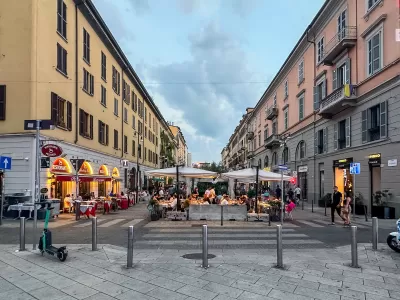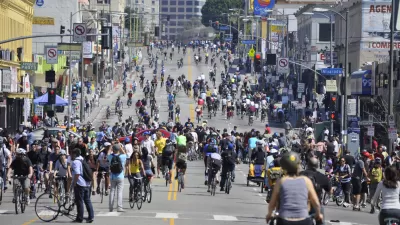The Covid era highlighted social inequities and prompted new paradigms for urbanism and mobility. Will they stick around?

How will urban design and mobility change in the post-COVID city? Scott Shepard shares his thoughts, noting that “After the initial shock and subsequent waves [of the pandemic], a new way of thinking began to quickly take hold.”
Cities around the country and the world began looking for ways to reverse decades- and centuries-old urban design paradigms, spurred both by changes wrought by the pandemic and by the threats of climate change. “This, along with public policies and investments in shared and active modes and a decarbonization of the transport sector collectively pointed towards a brighter future, and one decoupled from the 20th century modernist, car centric urban paradigm.”
Shepard sees promise in the reorganization of society forced by the pandemic and the changes that are persisting as the pandemic winds down. “Much is still needed to be done to help promote and develop in this manner, such as the 15 Minute City and new initiatives to help people take back control of public spaces from the automobile through tactical urbanism and DIY projects. However, this unprecedented era we live in is cause for celebration of our cities, and the potential they bring to a better quality of life for all groups and communities.”
FULL STORY: Urbanism & Mobility in the Post-COVID City

Alabama: Trump Terminates Settlements for Black Communities Harmed By Raw Sewage
Trump deemed the landmark civil rights agreement “illegal DEI and environmental justice policy.”

Planetizen Federal Action Tracker
A weekly monitor of how Trump’s orders and actions are impacting planners and planning in America.

The 120 Year Old Tiny Home Villages That Sheltered San Francisco’s Earthquake Refugees
More than a century ago, San Francisco mobilized to house thousands of residents displaced by the 1906 earthquake. Could their strategy offer a model for the present?

Opinion: California’s SB 79 Would Improve Housing Affordability and Transit Access
A proposed bill would legalize transit-oriented development statewide.

Record Temperatures Prompt Push for Environmental Justice Bills
Nevada legislators are proposing laws that would mandate heat mitigation measures to protect residents from the impacts of extreme heat.

Downtown Pittsburgh Set to Gain 1,300 New Housing Units
Pittsburgh’s office buildings, many of which date back to the early 20th century, are prime candidates for conversion to housing.
Urban Design for Planners 1: Software Tools
This six-course series explores essential urban design concepts using open source software and equips planners with the tools they need to participate fully in the urban design process.
Planning for Universal Design
Learn the tools for implementing Universal Design in planning regulations.
Clanton & Associates, Inc.
Jessamine County Fiscal Court
Institute for Housing and Urban Development Studies (IHS)
City of Grandview
Harvard GSD Executive Education
Toledo-Lucas County Plan Commissions
Salt Lake City
NYU Wagner Graduate School of Public Service



























